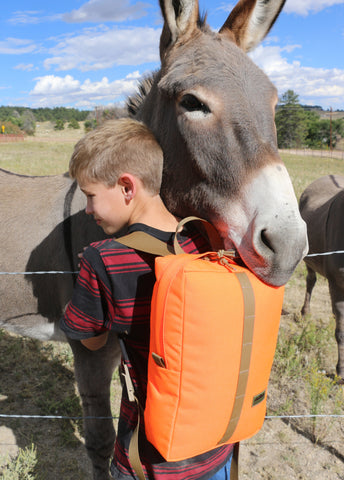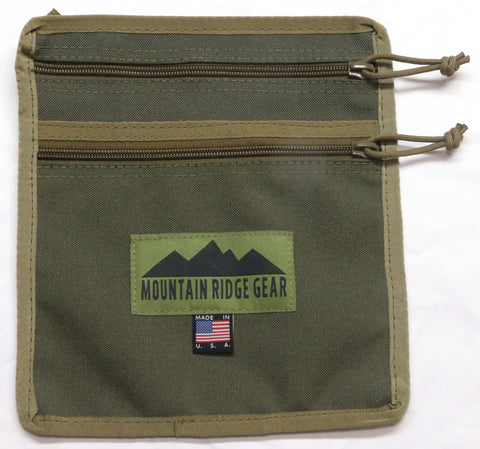I prefer wilderness areas in the back country of Colorado to hunt, fish and spend quality time. That is because I enjoy the remoteness and lack of mechanized modes of travel. As I get up in years my old football injuries and years of treating my body like an amusement park are making it harder to carry a 60 pound pack for a week-long archery elk hunt. A few years ago I was heading down the trail, deep in the West Elk Wilderness. As I made the long trek back to the trail-head, several groups of folks on horseback passed me. I must have looked pretty pitiful with my big pack and carrying my bow because they would say, “you need a horse”. After the third person mentioned my need for a pack animal I began to get a little irritated. As I plodded along I decided the next person who stated the obvious was going to get some snarky remarks from yours truly. I stopped to take a water break and as I sat there on an aspen log wiping the sweat from my brow and rubbing my throbbing knee I began to realize they might have a point.
As the weeks went past I rolled the idea around in my head. I grew up with horses so I was familiar with the idea of using them as pack animals. As I contemplated the use of horses I came to realize I would need more than one if I wanted to ride, pack gear and bring a hunting buddy. Out of curiosity, I checked Craigslist and quickly realized this was an expensive proposition. Here in Central Colorado good horses sell at a premium. Plus, there was the added expense of boarding, tack, buying a horse trailer and the cost of care and feeding. Anyone who owns horses will tell you that hay prices are as high as they have been in a long time. While horses or mules would be ideal, I couldn’t afford it. Of course, horses and mules are not the only option for hauling gear. Some folks use goats, a more affordable option. A large goat can carry up to 50 pounds of gear, so a string of 8-10 goats can haul a lot of gear. I was a little leery of the idea though. I figured I would be ringing a diner bell for a hungry mountain lion with a bunch of domestic goats in the back-country. Recently, the CO Department of Wildlife put the idea to rest for me. In the 2013 Colorado Sheep and Goat hunting brochure (page 3) there is a reference asking hunters not to bring goats in areas occupied by big horns and mountain goats because of the possibility of disease transmission. Soon, there may be regulations restricting pack goats in these areas altogether. In recent years llamas and alpacas have become popular. Llamas are being used primarily for packing but because an alpacas’ bone structure isn’t as robust as a llama’s they are used more for their wool. Llamas can carry between 75-100 pounds and walk around 2-2 ½ miles per hour, close to a human’s stride. We have all heard the stories about these animals spitting and I didn’t want to get spit on. I later learned that while llamas do spit, it is usually at one another and not humans. Nonetheless, I didn’t want to get caught in the cross-fire! The bottom-line was I did not know anything about llamas and goats did not appeal to me as pack animals. Because of my experience with horses I still felt most comfortable with equines.
The next summer I was doing some pre-season elk scouting and met a retired couple who were on horseback. They invited me to their camp for some burgers and cool beer, a real treat in the back country and made possible with pack animals. We started discussing horses, goats and llamas and I told them I was very interested in horses or mules but I could not afford them. So, they asked had I ever thought about using donkeys. The idea had never occurred to me. After all, you never see pictures of anyone in a hunting magazine packing out a big 6×6 elk using donkeys. I am horrible at remembering names so I have long since forgotten the names of the kind folks that filled my stomach with good food and my head with visions of pack burros carrying my gear. For the next year and a half I researched the idea.
A pair of Standard Donkeys (37”- 48” at the shoulder) can carry 225-300 pounds of gear. That’s a lot of creature comforts five to ten miles from the trailhead. I learned that donkeys are more economical than a horse, two donkeys cost about a third of a good horse. Also, care and feeding for a donkey costs considerably less than a horse. That is because donkeys do not require high protein food like alfalfa hay or sweet feed. They do well on good grass hay and do not require as much pasture space as a horse. For the most part, donkeys do not need to be shod because their hooves are harder than a horse’s. If need be donkeys can go longer without food and water than a horse. I liked what I was discovering. The more I researched the web, read books and talked to folks, the more the idea of using burros (the proper name if you live in the Western US) appealed to me. I am a bit of a history buff; it was interesting to discover that burros have an important historical significance in the founding of Colorado and the construction of most of the major towns and mining communities in the Rockies. As far as hiking with them, I liked the idea of being on the ground; it would ensure I stayed in shape. Chasing elk in the high country is a challenging endeavor and I did not want to get soft. Burros walk at about the same pace as a human so I would not need to worry about being stepped on. Second, if I was walking I’d have a much shorter distance to hit the ground if I fell as compared to falling off a horse. Some of the injuries I carry around are from my rodeo wrecks. If I hit the ground now like I did when I was a teenager I’d be in the emergency room! Finally, I do a lot of solo hunts so having a trustworthy travel companion to carry my gear, or me if I was injured, would be a good thing.
There are lots of derogatory words in the English language that have to do with donkeys. I have come to realize that those words were probably introduced by a horseman trying to work with a burro. Burros are smart animals, they learn very quickly. I try and work with my burros a lot; I expose them to as many situations as possible that I might encounter in the back-country. Looking back at all the hours I have put in to training them I’m not sure I “taught” them anything. Burros know how to cross foot bridges, creeks and load into a trailer I just had to figure out how to convince them to do those things. If I’ve taught them anything it is that they can trust me. For burros, building trust is the key. They need to know that what I’m trying to get them to do won’t kill them. Plus, I needed to convince them that whatever I was trying to get them to do was their idea. We have all seen the pictures of the old prospector pulling on the lead while the burro has his legs extended in a squatting position pulling back against the rope. I’ve come to learn this is not because the burro is stubborn (well in some cases it is). For the most part it is the burro’s attempt at communicating to me its confusion for what I am trying to get it to do. The student has really been me; I have learned so much about how a burro thinks and learns. Every time I spend time with them I come away a little smarter.
I bought my pair of burros from a friend who has raised them for more than 30 years. Buying animals from a repeatable person is the best way to ensure you are getting quality animals. However, there are other options. Many states have rescue shelters who take in abused, neglected or animals that need good homes. Colorado has a fantastic non-profit organization called Longhopes, (www.longhopes.org) located in Bennett. Give them a call and if you explain what you are looking for they will help set you up with the right burros. Another avenue is the Wild Horse Inmate Program (WHIP). Cañon City, CO is the home of the BLM’s largest wild horse and burro holding facility, and is one of five facilities in the nation with WHIP. The inmates work with the animals and offer them for adoption. To learn more check out the Bureau of Land Management’s web site, keyword search “Wild Horses and Burros”.
My burros were rounded up from BLM land in Arizona and trained by some friends before I bought them. I paid $900 for my them; I found a used trailer for $700, a year’s worth of grass hay runs about $800, I bought around $250 in tack and I built my own panniers. My total initial investment was approximately $2,700. In comparison, the conservative cost of a new ATV is about $9,500, $2,000 for a good trailer, $60 for helmets, plus fuel and maintenance. A burro can go places an ATV cannot go or is not permitted to go like wilderness areas. I like to call my burros “The Original ATVs”. Using burros has allowed me to go farther and stay longer in the back-country with creature comforts that I never had when I carried my camp on my back. Burros have also brought my family closer. Now I can take my kids along on more of my adventures. If they get tired from hiking I put them on one of the burros. If using pack animals has always been a dream of yours I urge you to explore burros. These fuzzy little long-eared critters are a joy to be around and may be a good fit for your outdoor lifestyle.
Tags
- American Made
- Backcountry
- Backcountry Adventure
- Backpacking
- Backpacks
- Bowhunt America
- Burro
- Burro Pannier
- Burros
- Camping
- Colorado
- Dana Rogers
- Day Hikers
- Day Pack
- Deer Hunting
- Donkey
- Elk Hunting
- Equine Riding
- Equine Training
- First Elk
- Hiking
- Hunting Equipment
- Hunting Gear
- Hunting Paniers
- Hunting Panniers
- Hunting Season
- Hunting Skills
- Hunting Supplies
- Jake Clark's Mule Days
- MRG
- Mule
- Mule Days
- Mule Deer
- New Mexico Elk Hunt
- Original ATV
- Outdoor Gear
- Outdoor Skills
- Outdoors
- Pack Animal
- Pack Animals
- Pack Equipment
- Pack Mule
- Pack Saddle
- Packing Equipment
- Packing Supplies
- Packing Tips
- Panniers
- Rockies
- Rocky Mountains
- Saddle Bags
- Saddle Mule
- Saddling
- Steve Edwards
- Trail Etiquette
- Trail Riding
- Western Riding Saddles
- Wilderness



Sam
Where can you buy burro s in alaska
Neal Dickey
I read the book Freemont. It was about John C Freemont.. They made 5 exploratory trips out west. They preferred mules and donkeys over horses for many of the reasons you mentioned like tougher, sure-footed, less delicate, ate less, etc.
Neal Dickey
I read the book Freemont. It was about John C Freemont.. They made 5 exploratory trips out west. They preferred mules and donkeys over horses for many of the reasons you mentioned like tougher, sure-footed, less delicate, ate less, etc.
Hunter peffers
If You Had to pack one burro for one year living off the land how wold you Pack and what wold you pack for that Year
Suzy cyr
Thanks.
I’m going to get me some.
I’ve had horses and my llamas never spit. But burros are less trouble and you can ride them